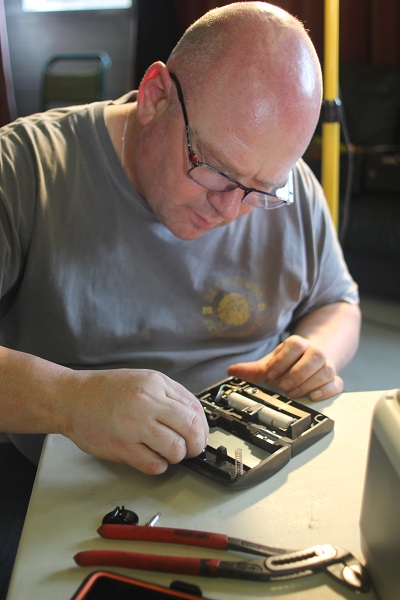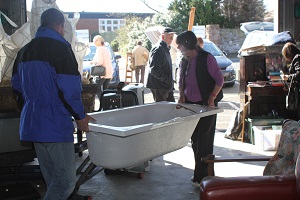If you've been to your local household waste recycling site lately, you'll have seen the amount of goods we throw away here in Cumbria.
 We live in a consumerist society, with lots of pressures to buy more things. As new goods replace old, more and more of our household goods end up being thrown away.
We live in a consumerist society, with lots of pressures to buy more things. As new goods replace old, more and more of our household goods end up being thrown away.
But there are ways to keep useful goods out of landfill. From TVs and phones to sofas and spades, our tips below can help you cut down the amount of goods you need to dispose of.
Run an event to save waste
Browse our range of factsheets for more ways to reduce waste in your community:
Factsheet-How to run an upcycling event
Factsheet-How to run a toy swap event
Factsheet-How to run a swishing event
Factsheet-How to run a Give and Take event
Get in a fix!
We’re often called a throwaway society, but more things can be fixed than you might think.
It can feel like nothing’s made to last these days, but many common items can be repaired and there are at least three great reasons for doing it:
- It might save you money if it’s cheaper to repair than replace
- The broken item won’t end up in landfill
- Fewer new items need to be made, which is good for the environment – fewer CO2 emissions from producing and transporting goods.
Here are a few tips that might help you get that broken bike or toaster back into use!
CAfS is running a series of four repair cafes on Alston Moor as part of our Alston Moor Greenprint project.
We’ve had two already, and there’ll be two more in 2019.
1. Check your warranty
Check if the item is still under warranty or covered by your household or gadget insurance first.
Depending on the problem, you might be able to have it repaired free of charge.
2. Have a go
You might be surprised at how many things you can repair yourself, without many skills or specialist tools.
YouTube is awash with how-to videos on fixing common problems, and there are helpful websites like ifixit.com with step-by-step instructions for repairing everything from phones and furniture to tools and kitchenware.
There are lots of dedicated websites for clothing repairs and popular items like bicycles. Or ask about classes at your local adult education centre.
3. Try a Repair Cafe
There are repair cafes popping up around Cumbria. Bring in broken items and volunteers will try to help you fix them.
There’s no charge but donations are generally welcome.
Keep an eye on the CAfS newsletter for details of your local one.
4. Bicycles
Bicycles in need of some TLC often end up being taken to household waste sites, yet they’re often quite easy to fix and they’re sought after on freebie websites.
Most cycle shops can help with repairs if you don’t feel able to try.
5. Phones & tablets
Ask at your local phone shop. Independent shops often refurbish and sell second-hand phones and may be able to repair yours at a reasonable cost.
Some of the national chains like Carphone Warehouse also offer a repair service.
If you want a phone that is designed to be fixed, have a look at the Fairphone. The company says: “The modular design and spare parts make it easy for anyone to repair.”
6. Computers
Most local computer shops will diagnose problems free of charge and can give you a quotation for the repair.
7. Household appliances
Most areas have firms or sole traders who can repair goods like washing machines and fridges.
Search online for firms near you and check the small ads in your local newsletter or newspaper.
Many electrical shops also offer a repair service.
8. If all else fails...
If you’ve given up on your broken item, why not try offering it on Freegle? Someone out there might have the skills to repair it or use it for parts.
And finally, if all else has failed, take it to your local household waste recycling centre if it can be recycled.
Give it away!
 Furniture, garden stuff, clothes, toys, tools… so many fantastic items with lots of life left in them get thrown away every year.
Furniture, garden stuff, clothes, toys, tools… so many fantastic items with lots of life left in them get thrown away every year.
Yet, with just a little effort, it can be easy to find a new home for most of the re-usable items you don’t want any more.
Here are just three ways that you could stop good stuff from going to waste. You might even help your community, too.
1. Donate it
Most towns have at least one charity shop where you can drop off things you no longer need – everything from books and DVDs to clothes and bric-a-brac.
There are lots of really good reasons for donating things to charity shops:
- You free up some space from unwanted clutter;
- People in your community get items they need at a low price; and
- Charities raise a lot of money to support their work.
About a fifth of the money that charities like Oxfam and British Heart Foundation raise each year comes from selling donated goods and other products. It just shows how your unwanted bits and bobs can make a really big difference in your community and the wider world.
Charity shops will accept most smallish items that are fit for resale. Some also accept electrical goods. If you want to give away large items like furniture and white goods, there are charities that accept these and some will even collect. Impact Furniture is one example in Carlisle. Search online for your nearest one.
2. Rehome it
You can list things you no longer want (or things you’re looking for) on websites like Freegle and Freecycle. They’re free to use, and everything changes hands free.
You can also post freebies on sales sites like Gumtree and some buy-and-sell groups on Facebook, too.
If you’re not so keen on online methods, you could try your local newspaper’s classifieds ads.
Here in Cumbria, you’ll find Freegle Give and Take events around the county from time to time. You can bring along items you don’t want and pick up some things you might need – all free.
About a third of the clothes in the average wardrobe haven’t been worn for a year or more*. One way to clear out unwanted clothes is to hold a ‘swishing’ (clothes swapping) event.
It could simply be with a group of friends, or an event in your wider community.
Swishing could be something for the adults to do at the next children’s birthday party or make it part of another get-together.
*Source: WRAP (Waste and Resources Action Programme). Visit their Love Your Clothes website for lots more ideas about buying, repairing and reusing clothing in a sustainable way.
Have a look at our handy guide to running your own swishing event and then give it a try!
